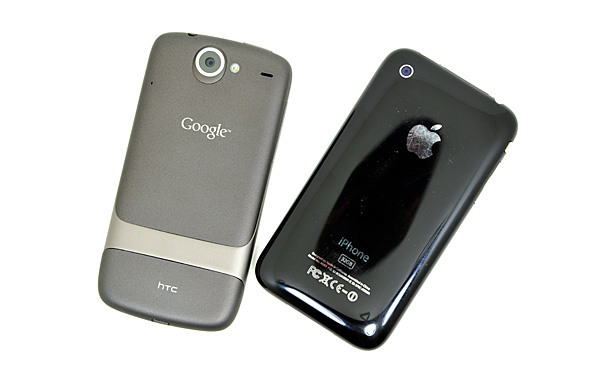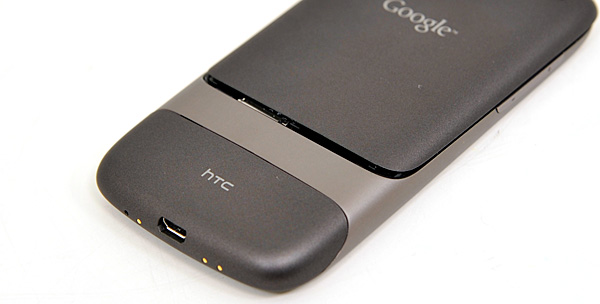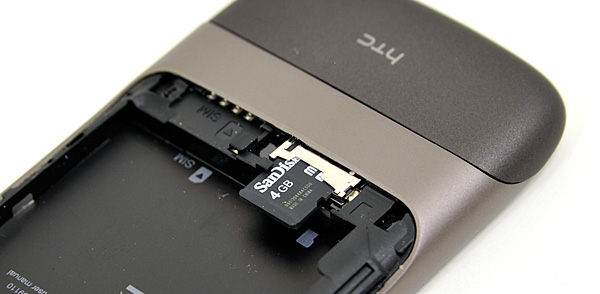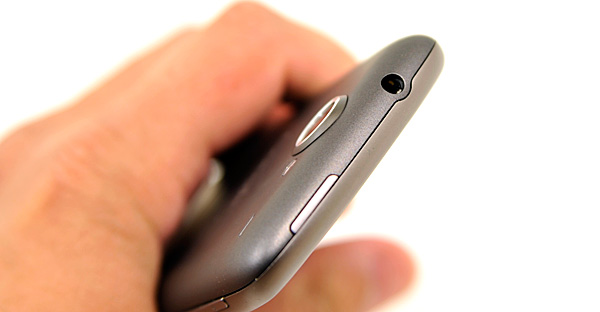Anand's Google Nexus One Review
by Anand Lal Shimpi on April 3, 2010 3:40 AM EST- Posted in
- Smartphones
- Mobile
Experiencing the Nexus, Without Whoopie
Announced in January 2010 and just updated last month to include support for AT&T's network, this is Google's Nexus One manufactured by HTC:

It's got a Qualcomm Snapdragon QSD8250 SoC (more on this later), 512MB LPDDR1, 512MB flash (where apps and the OS are stored), 4GB microSD card (for music/movies/photos) and boasts a 800 x 480 3.7" AMOLED screen.
The design is definitely not as cohesive as the iPhone, but here’s one area where Apple’s ID doesn’t really pay off - for a device that spends most of its life in your pocket, hand or next to your face - styling loses its value pretty quickly. The iPhone looks sleeker, but I’ll take the upgraded functionality of the Nexus One’s camera with flash any day.

The Nexus One is narrower, thinner but longer than the iPhone. The dimensions are as follows:
| Google Nexus One vs. Apple iPhone | |||||
|
Apple iPhone 3GS (ARM Cortex A8)
|
Google Nexus One (Qualcomm Snapdragon QSD8650)
|
||||
| Height | 115 mm (4.5") | 119 mm (4.7") | |||
| Width | 62.1 mm (2.44") | 59.8 mm (2.35") | |||
| Depth | 12.3 mm (0.48") | 11.5 mm (0.45") | |||
| Weight | 133 g (4.7 oz) | 130 g (4.6 oz) | |||
The form factor is both better and worse. Making the Nexus One thinner means that it’s more comfortable to hold up to your head as a phone. You don’t succumb to the iPhone conversation fatigue nearly as quickly. The downside is that the virtual keyboard is narrower, making typing more difficult than the already painful to learn (for some) iPhone keyboard. Personally, I don’t think the tradeoff is worth it. While I believe the Nexus One’s form factor is closer to ideal for carrying around, its keyboard (in portrait mode) is worse off because of it.

This is a normal smartphone after all, so you do get a removable battery. The back cover slides off to reveal a battery, micro SD card slot and SIM card slot. The removable battery is an important addition as you'll soon see. The Nexus One ships with a 4GB micro SD card from the factory.


Charging is done using a micro-B USB cable. Google provides one cable, one power adapter and a set of headphones in the box. The packaging is easily comparable to anything Apple ships. Even the plastic wrap around the cables feels soft to the touch.

You get a standard 1/8” headphone jack up top and to the left of it is your power/lock button. Initial boot on the Nexus One does take a while, I timed it at 48 seconds (that's PC-length!).

As with all other Android phones, you need a SIM and a Google account to make the Nexus One work. Simply typing in your existing Google/Gmail account works, or you can register through the phone’s interface. All syncing with the phone is done over the air and with Google’s servers.
Google doesn’t have a desktop OS (yet), and no thick client desktop apps. Rather than rely on building bridges between its smartphone OS and the desktop applications of its competitors, Google relies entirely on its cloud based services for syncing. Gmail, Google Contacts, Google Calendar, these are your new best friends. Already use all of them? Perfect - your Android phone syncs with your account and you’ll get all of your mail, contacts and calendar events immediately. If you don’t already use them then it’s a lane change. Not a difficult adjustment to make, but transitioning from desktop apps to something entirely cloud based does take some getting used to if you haven’t made the jump prior.










95 Comments
View All Comments
Antioch18x - Saturday, April 3, 2010 - link
Not only that but I didn't see mention of using a background task killer with "auto kill." (But, granted, I didn't *read* the whole article as I already own a N1 and didn't need to see your impressions of it). Due to the Android's method of multitasking, many times you don't actually exit an app when you think you do - it continues running in the background. You really do need a background task auto-killer to get the best battery life. This is one flaw, I think, in Android.Anyways, keeping this in mind I find that your battery life tests may be off. I get better battery life on my N1 than the old iPhone 3G.
spideryk - Saturday, April 3, 2010 - link
There are alternative keyboards available for the android. as of right now swype keyboard is the best available means of entering text on a smart phone. once you get used to swype, you only need one hand to type and most of the time do not need to look at the keyboard to type. a must have on android.bob1939 - Sunday, April 4, 2010 - link
Great review as usual but you missed something I consider critical. The lack of support for hands free bluetooth dialing.Where I live it can cost $180 if you are caught using a handheld phone while driving, so Hands Free dialing is a must.
Worse Google insists in calling his shortcoming an enhancement and shows no sign of fixing it in the near term.
For me this is a showstopper.
Bob Benedetti
dvinnen - Sunday, April 4, 2010 - link
Not sure what you mean by blue tooth dialing but there is certainly voice dialing. The whole voice integration in Android is really fantastic as Anand said in his review.bob1939 - Sunday, April 4, 2010 - link
I mean leave the phone in your pocket and press the button on the steering wheel, on the bluetooth speaker or bluetooth earpiece and say call whoever and the phone dials the number.My understanding of the N1 and other Android 2.1 devices is that you have to press something at least twice on the phone to operate the voice dial. Where I live that will cost $180 if you are seen by a cop fiddling with the phone while driving.
Bob Benedetti
LongTimePCUser - Wednesday, April 14, 2010 - link
I have a Motorola Droid and a 2006 Toyota Prius.The Droid connects via BlueTooth with the Prius.
I can dial a phone number on the Droid from the Prius touch screen.
joe6 - Sunday, April 4, 2010 - link
1) Good: Nexus One has a microSD card slot. Big advantage in my book.2) Bad: Nexus One doesn't support Exchange/Outlook calendar sync without going through the Google cloud services. This is just silly and frankly, kills the deal for me. I think most Nexus One RMAs come from this bullet alone.
Pitne - Monday, April 5, 2010 - link
There an app for this. How do you people miss the point that is android? Android is all about being open and not LOCKED DOWN like apple. So go download the more functional exchange apps and STFUCali3350 - Sunday, April 4, 2010 - link
Not sure if you posted it and I missed it or if you simply don't want to say in a public forum (which is understandable) but which do you , Anand, see yourself using in the future - the Nexus One or the iPhone 3GS? That sort of message says a lot about the current state of the platforms.Anand Lal Shimpi - Sunday, April 4, 2010 - link
Honestly, I'm torn.After the review I switched back to the 3GS because of the simplicity and the keyboard (I type a *lot*). In doing so, I miss the screen, form factor (ugh it was painful holding the iPhone to my head for an hour long phonecall vs. the Nexus One), some of the apps/features and the speed of the Nexus One. Today my answer would be the 3GS, but after using the Nexus One so much over the past few weeks I have to say that some aspects of the iPhone really do feel archaic.
What I may do going forward is continue to alternate between the two to get a better feel for their respective strengths and weaknesses.
Take care,
Anand